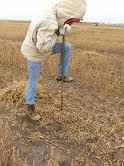Soil Sampling for Fertilizer Application Plans for the 2016 Growing Season

Following are some things to keep in mind while soil sampling this fall:
- A soil sample which does not represent the area being sampled will be misleading and result in over or under-application of fertilizer. For example, soil sampling a plowed field. It is therefore very important to collect and handle soil samples properly.
- Soil sampling is encouraged immediately following early crop harvest, including winter wheat, canola and spring wheat, otherwise soil sampling after chisel plowing stubble can result in unreliable soil test results. Potassium nutrition is complex.
- Soil clay chemistry plays a much larger role than taught in school. Soil minerals such as potassium feldspar, prevalent in many ND soils is an important contributor to seasonal plant nutrition than previously thought. Soil sampling schedules should be as consistent as possible. For example, soil exchangeable potassium will test lower following corn than following soybeans, since seasonal potassium uptake by corn is larger than for soybeans during the cropping season.
- Soil K is highest in the early spring, with rapid or gradually decreasing K into June, holding relatively steady at a low level until fall when rain leaches K from standing stubble before and after grain harvest, which causes soil K values to again start to increase. Potassium soil test may be done once every 3-4 years for most soils (except low K sands).
- Soil P, Zn, and pH are relatively more stable over a growing season so time of year is not very important. These three factors are especially important for some crops grown after beets, and canola, which don’t form mycorrhizal association with their roots.
- Fall soil sampling results for NO3-N and sulfur are similar in most years to spring sampling. However, warmer than normal winters followed by an early spring combined with good soil moisture could increase NO3-N and SO4-S levels through organic matter and residue mineralization. Green sugar beet leaves or other crop residues with relatively high N content may also contribute to early mineralization and increase spring NO3-N levels compared to a fall soil sampling. In sandy soils with high rainfall or snow-melt following a fall sampling, levels of NO3-N and S in the spring compared to a fall sampling may decrease as nitrate and sulfate are leached out of the sampling zone. In most situations, however, fall sampling is a good guide to N and S application. Note that sulfur analysis in soil is not reliable.
Acknowledgement: Dave Franzen.
For further reading, please visit Dr. Dave Franzen’s publications on soil sampling at https://www.ag.ndsu.edu/cpr/soils/soil-sampling-following-early-crop-harvest-08-13-15\ and Soil sampling as a basis for fertilizer application.
Please visit NDSU website on how to soil sample and submit for analysis at: https://www.ndsu.edu/soils/services/soil_testing_lab/how_to_soil_sample/.
Jasper.Teboh@ndsu.edu
Soil Scientist


